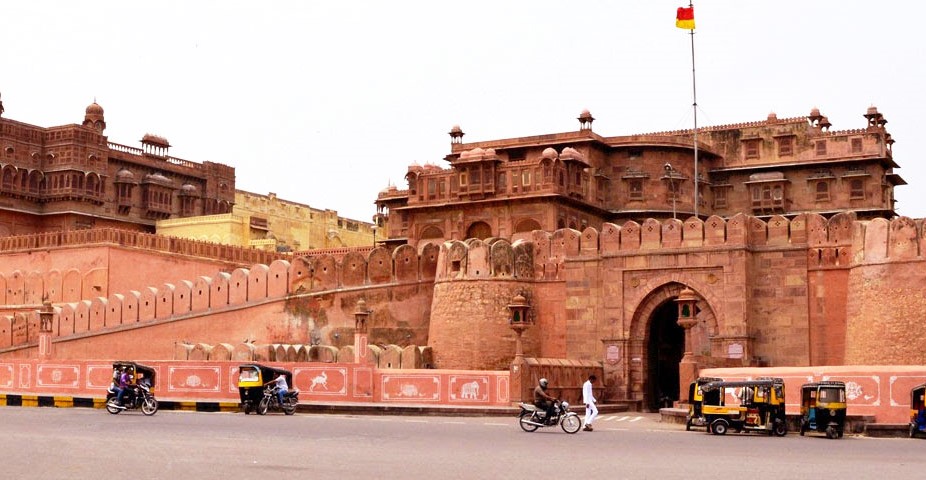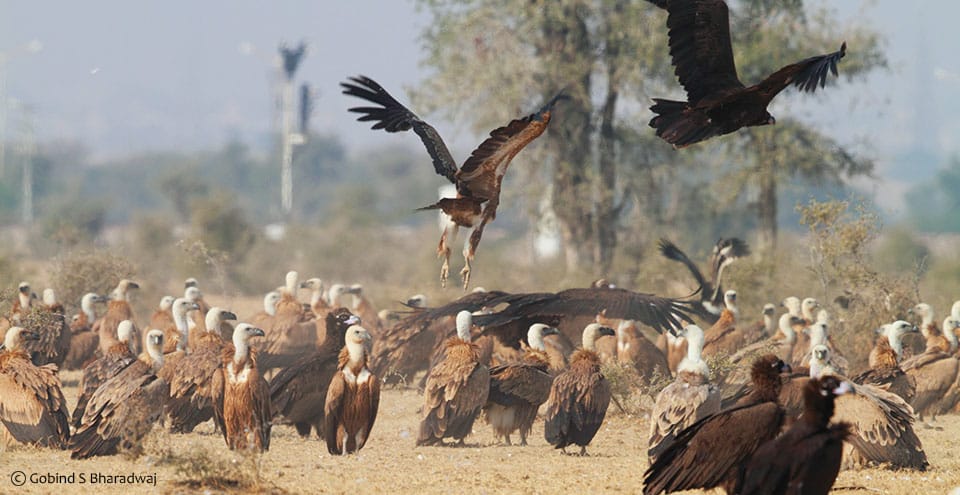
Bikaner
Bikaner (बीकानेर) is a city in the northwest of the state of Rajasthan, India. It is located 330 kilometres (205 mi) northwest of the state capital, Jaipur. Bikaner city is the administrative headquarters of Bikaner District and Bikaner division.
Formerly the capital of the princely Bikaner State, the city was founded by Rao Bika, a Rajput chief of the Rathore dynasty in 1488 CE and from its small origins it has developed into the fourth largest city in Rajasthan. The Ganga Canal, completed in 1928, and the Indira Gandhi Canal, completed in 1987, facilitated its development.
Geography of Bikaner
Geographically the city is located at an average altitude of 797 Feet and witnesses extremities of temperatures. The city lies in the western desert part of the state. Vegetation in the area reflects the scarcity of rainfall. You can find thorny bushes and cactus plants scattered all over the region. You can also find some seasonal dwarf plants, grasses and few shrubs here. The main agricultural crops include kharif and Rabi crops such as Bajra, mustard, wheat and pulses.
The weather remains quite hot during the summers, when the temperature ranges from 28 degree to 42 degree centigrade. The climate remains quite pleasant during the winters, when the temperature varies from 5 degree to 23 degree centigrade. During the monsoon seasons, the rainfall varied from 26 cm to 44 cm. The best time to visit the city is from October to February.
Places of Interest

Junagarh Fort
It is an unassailable fortress, which has never been conquered. Built in 1593 A.D. by Raja Rai Singh, one of the most distinguished generals in the army of Emperor Akbar, the fort is a formidable structure encircled by a moat. The fort complex houses some magnificent palaces constructed in red sandstone and marble and visitors can feast their eyes on an attractive assortment of courtyards, balconies, kiosks and windows.

Lalgarh Palace & Museum
This grand palace is an architectural masterwork in red sandstone, and was built by Maharaja Ganga Singh Ji in the memory of his father Maharaja Lal Singh Ji in 1902. Sir Swinton Jacob designed this oriental fantasy. This architecture is a fusion of Rajput, Mughal and European architecture. The exterior contrasts dramatically with the oriental interiors and amenities.

Gajner Palace
Gajner is an incomparable jewel of the Thar. The Gajner Palace was founded by Maharaja Gaj Singh ji of Bikaner in the year 1784, and then completed by the great Maharaja Ganga Singh of Bikaner on the banks of the lake. It was meant to serve as a hunting and relaxing lodge for the royal family as well as for visiting guests. It has now been converted into a hotel.

National Research Centre on Camel
The National Research Centre on Camel is 8 kilometres from the city. This camel research and breeding centre is the only one of its kind in Asia. The centre is spread out over 2000 acres of semi-arid land and is managed by the Government of India.The Centre offers camel ride facility along with selfi points to tourists. Tourists can also enjoy here various camel milk products i.e. flavored milk, camel milk coffee, kulfi, cheese etc.

Rampuria Haveli
Bikaner has several havelis (aristocratic homes), the most famous cluster being the Rampuria Group of Havelis. Built of dulmera (red) stone, every aspect of the havelis – jharokhas (casements), entrances, latticed windows, divankhanas, gumaharias or basements – is simply exotic. These massive havelis are decorated with golden work of the highest quality. Their dankhanas (drawing room) take one back to the Mughal and Rajput era. The wood carvings in Rampuria Havelies are extremely exquisite. Spaced close to each other, the havelis are truly a sight to behold.

Laxmi Niwas Palace
Laxmi Niwas Palace was the residence of the king of Bikaner, Maharaja Ganga Singh. Built between 1898 and 1902 by British architect Sir Samuel Swinton Jacob, this structure displays an Indo-Saracenic architectural style. It is now a luxury hotel.

Karni Mata Temple
The Karni Mata Temple at Deshnok is a beautiful structure made of stone and marble, inside which resides an image of Karni Mata. The image is decorated with a ‘mukut’ (tiara) and garlands. The images of her sisters and the sisters of Avad Mata give her company on either side. The temple is known the world over for the presence of kabas (rats) that roam freely within the temple precincts.

Jorbeed
Bikaner in Rajasthan is one of the best places for birders if they want to spot some vultures. But, drive for about 12 km from the city, and you reach Jorbeed. Birds like the Steppe Eagles, Griffon Vultures, and Egyptian Vultures are as common as crows in this region. A place you’ll certainly have to come to terms with, you will hardly see a single tree here without some or the other raptor resting on it. A visit to Jorbeed is all about seeing the largest congregation of eagles and vultures in Asia, and if you are lucky, you might even spot the rare yellow-eyed pigeon here as well.

Raisar Dunes
The site is situated on Bikaner Jaipur highway 18 Km far away from Bikaner city at Raisar village. This site has been emerged as an prominent camping & safari site which has gathered prestigious place among the tourist for desert safari, camel safari, camel cart ride, jeep safari and night camping. The huge, untouched & less vegited sand dunes of raisar put this site at par to sam sand dunes of Jaisalmer.

Gajner Wildlife Santuary
Barely 32 kilometres from Bikaner, on the Jaisalmer road, is a lush green forest which is a haven to the nilgai, chinkara, black buck, wild boar, flocks of imperial sand grouse and many other species of migratory birds that make the sprawling forest their winter home.
How to Reach Bikaner
Flight : Nearest Airport NAAL 10 KM from Bikaner direct connectivity from Delhi as well as Jaipur.
Car : The bus stand is north of the city centre. There are frequent express buses to Agra, Ahmedabad, Ajmer, Barmer, Delhi, Jaipur, Jaisalmer, Jhunjhunu, Jodhpur, Kota and Udaipur.
Train : Bikaner has railway connections to several destinations in India including Jaipur, Jaisalmer, Churu, Jodhpur, Delhi, Mumbai, Kolkata, Guwahati etc.



